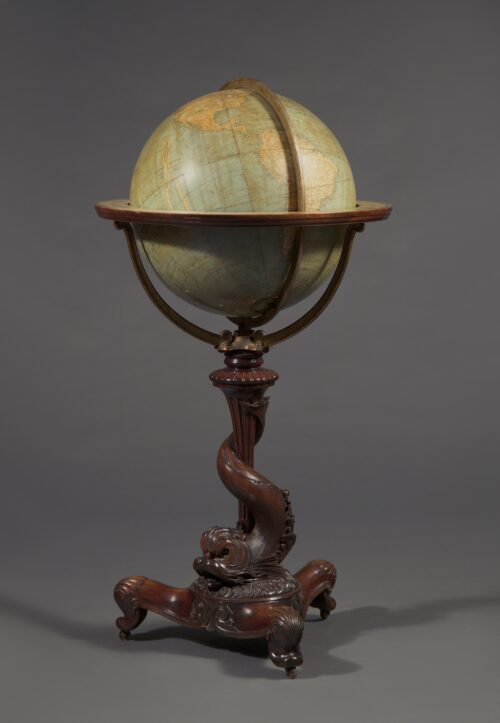11769 A FINE QUALITY TERRESTRIAL FLOOR STANDING 18″ GLOBE SET ON A SUPERBLY CARVED MAHOGANY DOLPHIN FORM BASE English. Late 19th Century. Measurements: Height: 46 1/2″ (118 cm) Diameter: 24″ (61 cm)

Research
Of mahogany and gilt brass. The globe made up of polychrome printed gores, enclosed by an engraved brass meridian ring within a horizontal circle raised on scrolled brass supports. The carved stand with tapering fluted pedestal encircled by a dolphin, on a carved tripod base with scroll and shell motifs and raised on casters.
The origins of celestial and terrestrial globes extend to antiquity, when philosophers and astronomers first began to conceive of the earth and heavens as spherical in form. The idea of a sphere-shaped universe developed first, possibly as early as in Biblical times, and had been widely accepted by the time the Pythagorean philosophers in Greece first suggested that the earth was also a sphere. According to cartographer and historian Edward Luther Stevenson, the Pythagoreans’ reasoning was “that the earth is a sphere because that is the most perfect form, that it is located in the center of the universe because that is the place of honor, and that it is at rest because rest is more dignified than motion”.1 Aristotle later defended their position using perhaps more substantive arguments: the theory of gravitation (that particles of matter have a tendency to congregate in the middle, making a sphere) and his observation of the earth’s round shadow cast onto the moon during an eclipse. While celestial globes were common in antiquity, terrestrial globes were not introduced until the second century B.C., when Crates of Mallus created one that was mentioned in the writings of the geographer Strabo (ca. 63 B.C. to A.D. 24).
Full research report available on request





Comments are closed.